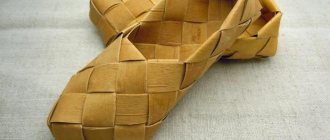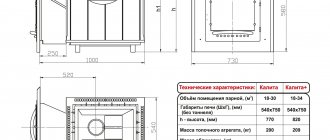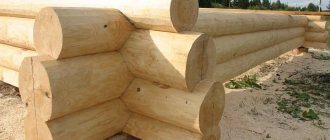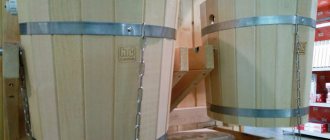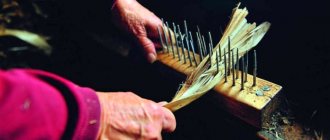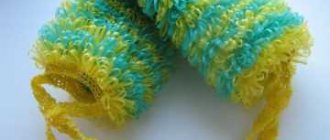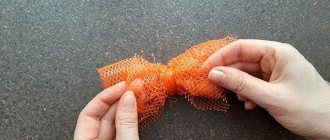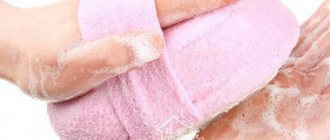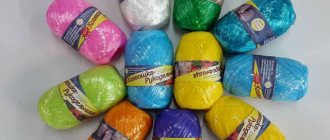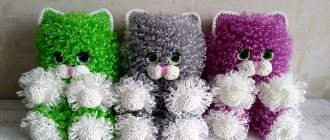This personal hygiene item was known to humanity at the very dawn of the bath culture. The ancient Greeks used bronze and crushed marble chips to cleanse the skin, the Romans used pumice, the eastern peoples used sand, our ancestors used wood ash and linden bast. Nowadays, during the triumphant procession of hand-made items, one is just asking for a washcloth made by oneself to be placed on the bath shelf, and not purchased on sale at the nearest household chemicals supermarket. Well? Let's evaluate the possibilities and consider options?
Crocheted washcloth with elongated loops, the work of our readers
Our master classes and video lessons will tell you how to crochet a washcloth.
Crocheting washcloths, master class!
The author of the description is Noskova Nadezhda. Nadezhda writes that knitting is her hobby! Today she will tell you how to crochet a washcloth.
Crochet washcloth, step by step description
First we knit 40-45 chain stitches and connect them into a circle.
We tie 5 rows with single crochets, then begin to pull out the loops (see photo).
After pulling, the loops must be secured with an air loop (see photo), otherwise they will crawl out to the wrong side and the washcloth will turn out flabby.
We knit the length of the washcloth individually (expecting that it will stretch during use). We finish by tying with single crochet chain loops and tying the handles. A skein of thread costs 25 rubles, enough for 2 washcloths. And cheap and beautiful!
You will need yarn for knitting washcloths and a size 4 hook.
What do dictionaries say?
In reference books, this word is interpreted as the young bast of some trees, which is divided into strips and thin fibers. Dahl's dictionary adds a definition: bast is a fragile subcortex. The tree tissue located directly under the bark is called bast. Behind it is young wood. The Brockhaus and Efron dictionary explains how bast was extracted: they cut down a young tree, cut off its branches and cut off the bark along the trunk. This activity is called “pulling the bast.” The best bast comes from linden. The proverb “ripped off like a stick” just speaks about this type of fishing.
Dictionaries unanimously state that “lyko” is a word used only in the singular. That is, you cannot say: “I kicked a lot.” It would be correct: “I kicked a lot.”
Bast is pulled from willow, elm, and oak. The Scientific and Technical Encyclopedic Dictionary says that this is done in the spring. Trees are selected no older than ten years. Remove the bark of approximately three arshins in length. This is about two and a bit meters. Afterwards, the top crust is removed, the bast is soaked, dried and put into use.
Crochet washcloth video tutorials
Crocheted washcloth toy “Clean Bear”
The toy has eyes, a nose and ears. On one side it is shaggy, and on the other side it is smooth and has a comfortable handle.
To knit a washcloth you will need:
- polypropylene threads of three colors: any main color, black and white for the eyes
- scissors
- needle
- hook No. 2.5, hard so as not to bend
Part 1 The video should load here, please wait or refresh the page.
Part 2 The video should load here, please wait or refresh the page.
Crochet round washcloth for beginners
We will need: yarn; hook number 3.
The video should load here, please wait or refresh the page.
Crocheted washcloth toy “Funny hedgehog”
- polypropylene thread 70-80 g primary color
- polypropylene thread black, white, green and red
- hooks No. 2.7 and 4.5
- darning needle with wide eye
- scissors
- template to make a flower
The video should load here, please wait or refresh the page.
The video should load here, please wait or refresh the page.
Crochet washcloth with spiral pattern
The video should load here, please wait or refresh the page.
How to crochet a washcloth hard and soft
How to knit a washcloth 2 in 1, hard and soft, crocheting for beginners, video tutorial. To knit a washcloth, we need Needlewomen yarn in three colors, hook No. 4. Washcloths for men (hard side) and women (soft side). We knit the hard side lengthwise and the soft side across.
Story
Lubok depicting a bast worker at work
The first mentions of bast in Russian sources date back to the 12th-13th centuries. In particular, the chronicle from 1205 names bast as one of the tribute items:
Woven bast shoes have long been known among the Eastern and Western Slavs, among the Baltic peoples, among the Finno-Ugric peoples and in the coastal regions of Sweden. Until the 15th century, the equipment of Russian troops included chain mail made of oak bast and bast shields. From the same material in Russia “they wove baskets, boxes, coolies, tues and even chairs and tables.” However, bast was most often used in the production of bast shoes. Back in the 18th century, this type of footwear was popular not only among peasants, but also among townspeople. Until the second half of the next century, bast bast shoes remained the main footwear in villages and hamlets of the black earth provinces.
Entire settlements and even regions were engaged in the production of shoes from bast. Among them is the village of Smirnovo in the Nizhny Novgorod province, where the famous “Smirnovsky bast shoes” were made; the village of Semyonovskoye (near Kineshma); village of Myt, Shuisky district (Vladimir province). Tambov craftsmen supplied bast shoes “to all of Russia, including the Red Army...”.
Researchers have traditionally viewed bast bast shoes as an attribute of peasant life, a kind of evidence of the “poverty of the ancient Russian peasantry.” According to an alternative point of view, until about the 16th century, bast shoes were not as widespread as leather shoes, and were used mainly during agricultural work (in the field, in the forest, etc.). Later, with the rise in leather prices, bast shoes began to displace boots from the everyday life of peasants.
Where is bast used?
Bast is not just washcloths. From time immemorial, bast was used to weave bast shoes, household utensils, baskets, boxes, and so on...
Lyko became so firmly established in the lives of Russian peasants that it would be difficult to imagine their life without him.
There are quite a lot of proverbs and sayings associated with bast. For example, our everyday saying: “The bast does not knit.” This means that a person is drunk to such an extent that he cannot cope with an ordinary, simple task.
Shoes and household items made from bast were considered a sign of the poor and of simple origin. When they said about a person: “Girded with bast” or “Woe is bast” - this meant that the person lived in poverty.
The bast washcloth is one of the oldest. These are the types of washcloths that have replaced “disposable cleaning agents.”
Lapti
Perhaps the meaning of the word “bast” is easiest to explain using the example of bast shoes.
Everyone knows what bast shoes are. These simple shoes served people not only in Rus', but also in Finland. If in Europe they preferred wooden shoes - clogs, then our ancestors liked light bast shoes. A pair of such shoes for an adult requires three linden trees. A man engaged in peasant labor wears them out in a week. Therefore, everyone knew how to weave bast shoes. It was a common, uncomplicated matter. A block was used for weaving.
Almost all people in Rus' wore bast shoes, so the country was called “bast shoe Russia.” Bone kochedyki (devices for weaving bast shoes) are found by archaeologists during excavations of the Stone Age era. In the Tale of Bygone Years we find the word “lapotnik”. There were artels that went into the forest to tear the bast with a pyrk - a wooden tool that left a bare trunk. The cart yielded three hundred pairs of bast shoes. Peter the Great himself learned to weave bast shoes.
About disposable washcloths
Initially, the role of a washcloth in a bathhouse was performed by a bunch of straw or ordinary grass. Grass or hay was collected in a bunch, doused with warm water to wash away possible contamination, and the simplest bath attribute is ready for cleansing procedures!
Everything would be fine: the herbs are good for the skin, and the hay smells like summer. Disposable washcloths are individual, they are not capable of transmitting infections and diseases to other visitors to the bathing kingdom.
But such washcloths do not have reliability, rigidity, or long service life. So the bast soap came to the rescue, it rubbed conscientiously and lasted much longer than disposable washcloths.
A bast hangs on a stake
The saying about the mop has real roots. Having removed the young bast (which means bast) from the tree, it was placed in ditches filled with water for soaking - mochila. They were placed near forest streams and rivers. By autumn, it was hung out to dry, and then carried through the snow on a sleigh to the village. When thoroughly soaked bast was tied into bundles, it disintegrated into many fibers.
Sometimes this happened while it was drying out. Such fibers can be seen at the market or agricultural fair. In Rus' they are called “mochalo”. This is where the word “wetten” comes from, that is, cut into small fibers so that the previous shape is lost.
There is no Russian bath without a sponge and a broom. This eco-friendly material was used for massage, and our ancestors did not know the disease. The tradition of washing with a washcloth is very ancient. Brushes and brushes were made from bast bundles, they were used to whitewash stoves and fences, clean kitchen utensils, twist ropes, and make coarse threads that were used to sew together nets for fishing.
Dolls were knitted from bast, and not only for children's games. In the peasant hut there were many amulets: a large doll, lovebird dolls, a swaddling doll, a kuvadka, a small egg. There was a doll for every event in family life.
Not only fishing nets were woven from bast, but also horse harness, matting, and in Germany even raincoats. In the old days, upholstered furniture was stuffed with bast. Instead of refrigerators, they used linden containers. Tueski wove according to the example of bast shoes. They are good for storing butter and caviar.
Properties of bast sponge
Any natural washcloths are hard! They do an excellent job of deep cleaning pores. The phytoncides for which linden bast is famous kill all microbes that it encounters on the skin!
The bast sponge has an excellent scrub effect that lasts until the last days of its service, but there are also some inconveniences when using it...
The fact is that thin strips are not physically prone to excessive foaming.
Often, manufacturers do not give the bast a specific shape, and when you buy it in a bag, you will be greeted with the usual bunch of thin strips connected by the bast strip itself.
To make washing in the bathhouse a pleasure and for you to feel a shapeless tow in your hands, I suggest making your own washcloth from purchased bast material.
The strips can be tied into a braided shape, or they can be sewn onto a piece of fabric, or they can simply be secured on both sides with a rope.
The bast sponge has one more not very pleasant property - it comes out. When rubbing and lathering, tiny pieces and hairs fall off in large quantities.
Cleaning the bathhouse after using a washcloth will be a must!
Important! If you decide to use a bast sponge at home in the bathroom, the bast can clog the entire drain. Be careful!
And of course, any natural washcloth must be dried thoroughly! Bacteria and microbes love to live in a moist, natural environment - this is paradise for them!
Due to such proximity, natural washcloths often rot, acquire an unpleasant odor and do not last long. The washcloths need to be dried, and before use, be sure to steep them in boiling water so that they fluff up and become soft.
Receipt and use
Extraction and pre-processing of bast
Bast prepared for further use
Tambov peasants harvested bast in the spring: at this time, “young trees called lutoshki were cut down in the forest. Having cut off the branches of the felled tree, they began to tear off the bast, which looked like stripes...” In the North of Russia, it was customary to harvest raw materials for weaving “from the Annunciation to Trinity, since at this time the bark is still soft.” The inner part of the bark removed from the linden tree was subjected to special processing. For example, among the Mordovians, bast was soaked in water to give the material the necessary flexibility.
In Northern and Central Russia, bast craftsmen had certain “standards” related to learning the craft, the beginning and completion of work, and the timing of bast harvesting. One of the Vladimir peasants described the process of transferring skills from generation to generation: “My father taught my brother from the age of six... First to go for the bast, then to soak it, and then weave.”
Manufacturing of shoes and other household items
Main article: Lapti
Body made of birch bark and bast, early 20th century
One of the researchers describes the properties of bast and the technique of weaving bast shoes among the Mordovians:
To make “two-heeled” bast shoes, or “seven-heeled” bast shoes, carefully cleaned bast was used. Such bast shoes were kept in the sun for a certain time, after which “the front side of the stripes became dark brown.”
It is noteworthy that bast shoes received their name depending on the type of tree from which the bast was removed. Thus, “vertizni” were made from the bark of the willow tree, and “shelyuzhniki” were made from tal. “Fools” were woven from the bast of a young oak tree, and “birch trees” and “elm trees” were woven from birch and elm bast. However, the most durable bast shoes were made from the bast of a young linden tree. In this case, the thickness of the tree should not exceed one and a half inches.
Not only shoes, but also other household items were made from bast. Thus, in the life of the Mordovians, one of the main elements of utensils was a “purse woven from bast.” The latter looked like a quadrangular box made up of two halves. Such a wallet was created through “oblique weaving”, using corners and edges. On opposite sides of both parts of the “box” “four bast loops” were attached, into which a strap or twine was threaded.
